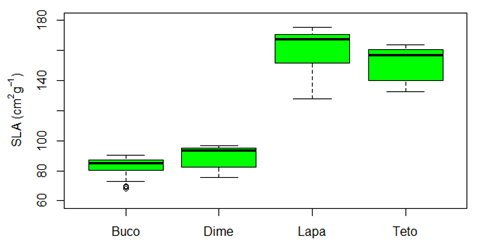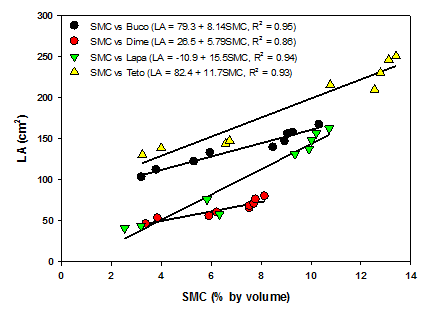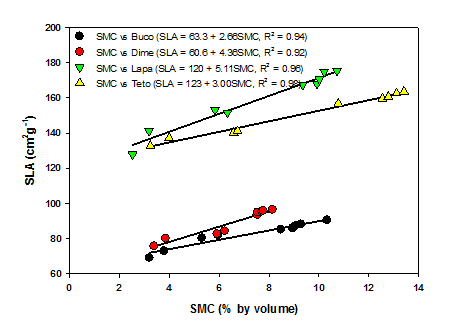International Journal of
eISSN: 2576-4454


A functional trait–based approach provides insight into the functional variations between and within tropical deciduous forests across large gradients of SMC. To test this hypothesis, we selected nine forest fragment sites in the tropical deciduous forests of India, which exhibited significant variations in SMC. At all nine sites, we measured leaf area (LA) and specific leaf area (SLA) of the four deciduous tree species (viz., Buchanania cochinchinensis, Diospyros melanoxylon, Lagerstroemia parviflora and Terminalia tomentosa), commonly observed in the forest region. We recorded significant differences for LA and SLA for the four deciduous tree species across the nine study sites in a gradient of SMC. The inter-species and within species differences were also significant. LA and SLA of the four tree species exhibited strong positive linear relationships with SMC across the nine sites. These variations in functional traits were mainly controlled by SMC. We suggest that LA and SLA are important functional traits for detecting the effects of variations in SMC on the physiology and distribution of trees in tropical deciduous forests. LA and SLA are the key functional traits which are linked with major ecosystem processes, and proper research on these traits of the deciduous trees could help in categorizing tree communities for the sustainable development of the tropical deciduous forest ecosystems.
Keywords: Tropical deciduous forest; soil moisture content; leaf area; specific leaf area
Tropical deciduous forests experience total annual precipitation ranging from 700–2000mm, and a mean annual temperature of 25°C.1 [The favourable growing period in these forests is very short, during which the soil moisture content (SMC) is adequate for plant growth, while three or more consecutive months, each year are dry with almost no rainfall.2 The dominance of drought deciduous trees in the tropical deciduous forests indicates that deciduousness is the most important adaptation to seasonal drought, which results into shedding of leaves and reduction of physiological activities during the unfavourable dry season.2‒4 Due to spatial and temporal heterogeneity of resources and wide variations in adaptive strategies, tree species of these forests exhibit high inter-specific variation in functional traits.5‒7 These functional traits have been reported to exhibit direct or indirect association with plant population and ecosystem processes.3 According to de Bello et al.,8 specific ecosystem processes could be influenced by a combination of functional traits, whereas few important key traits could simultaneously affect multiple processes. Therefore, the investigation of inter-specific variation in functional traits would be able to explain the patterns and tradeoffs in plant structure and physiological functioning, and the effects of shift in species composition on the functioning of ecosystem.
Functional traits that help plants in acquiring limiting nutrients and water are more important for tropical deciduous species. The pattern of plant water uptake from variable soil depths, which commonly show spatial and temporal differences among various plant functional groups or types, may directly affect soil water dynamics in the growing season.3,9,10 Leaf size or Leaf area (LA), i.e., the one-sided projected leaf surface area, is an important component of plant growth investigations and evapotranspirational measurements. It also has large effect on the rate of transpitation (E).11 It is important parameter in the analysis of tree canopy architecture, since it is useful in determination of LAI. It is associated with canopy light interception as well as photosynthetic efficiency and plays an important role in carbohydrate metabolism, accumulation of biomass, yield and RGR.12‒14 Interspecific differences in LA has been associated with variation in climatic condition, geology, altitude or latitude, particularly in the region where stress due to heat, cold, drought and high-radiation leads to the selection of species with relatively small leaves. Within a particular climatic zone, variations in LA can also be associated with ecological strategy and allometric factors, such as plant height, twig size, architecture, etc., with respect to soil nutrient stress and environmental disturbances, whereas phylogenetic factors may also play a significant role.
Specific leaf area (SLA) is defined as the light-capturing leaf surface area per unit of dry biomass, exhibits a trade-off between capture of resources and their conservation15 and has been reported to have significant correlation with net photosynthetic rate, leaf life-span, relative growth rate, wood specific gravity, and competitive ability.16 SLA is considered to vary with leaf phenology, and deciduous species exhibit higher SLA, while evergreen species account lower SLA values, which represents a trade-off between shorter leaf longevity with high resource capture ability and longer leaf longevity with low resource capture ability.16 Variations in SLA are likely significant for the species coexistence in tropical deciduous forests, because greater variation in SLA within a particular community might allow large number of species to partition the available resources across the highly variable environment.1,3,17 The investigation of magnitude and patterns of variations in functional traits in tropical deciduous forests as compared with other ecosystems is important for understanding the assembly of plant communities in deciduous forests as well as for understanding pattern of species distributions within as well as between tropical deciduous forest ecosystems and across dry–wet transitions in the forest region.18
Soil water availability has been considered to influence major ecosystem processes2,4 and the functional traits of deciduous trees.2,3,19,20 Within other forests, SLA has been reported to play a significant role in the assembly of plant species across the gradients of light availability and soil moisture content (SMC).15 Although spatio-temporal variation in SMC drive habitat associations as well as niche partitioning within tropical forest ecosystems,21 whether differences in plant functional traits for e.g., LA and SLA exhibit shifts in plant distribution patterns both within and between tropical deciduous forests is unknown; however it would provide a possible insight to distinguish tropical deciduous forests. In this study we have measured LA and SLA in four common deciduous tree species from nine forest fragments exhibiting significant variations in SMC. The study was conducted in the forests of the Vindhyan highlands located in the Sonebhadra District of Uttar Pradesh, India (21°29ʹ–25°11ʹ N and 78°15ʹ–84°15ʹ E). The area experiences a tropical monsoon climate with three seasons in a year, viz., summer (April–mid June), rainy (mid June–September), and winter (November–February). The months of March and October constitute transition periods, respectively, between winter and summer and between rainy and winter seasons. The maximum monthly temperature varies from 20° C in January to 46° C in June, and the mean minimum monthly temperature reaches 12° C in January and 31°C in May. According to the data collected from the meteorological stations of the state forest department for 1980–2010, the mean annual rainfall ranges from 865 to 1,196mm.22 About 85% of the annual rainfall occurs during the monsoon (rainy) season from the southwest monsoon and the remaining from the few showers in December and in May–June. There is an extended dry period of about 9 months (October–mid June) in the annual cycle.6 The monthly rainfall varies from 6mm in April to 334mm in August.23 Soils of the study area are residual ultisols, sandy-loam in texture, reddish to dark gray in color, and extremely poor in nutrients.7 The forest region exhibits patchiness in the species composition due to small variations in the environmental variables.17 Species composition, distribution, and diversity24 and seasonal growth.18-27 of woody species are highly influenced by the soil moisture content. The density dbh distributions in the forest region exhibited a low dbh-biased structure, where the average densities of seedlings, saplings, and adults were 9,261 1,511, 799 154, and 297 62, respectively.24
We selected nine forest fragment sites in the Vindhyan Highlands, which exhibited significant variations in SMC (Table 1). Among the nine selected sites, the minimum distance between the two sites was at least two kms. Functional traits were measures on the four deciduous tree species (viz., Buchanania cochinchinensis, Diospyros melanoxylon, Lagerstroemia parviflora and Terminalia tomentosa), commonly observed in the forest region.24 At each selected site (9), we randomly marked three individuals (>10cm DBH) from each of the four tree species (9×3×4=108trees), for functional trait measurement. For measurement of LA and SLA, 30 mature and healthy, sun facing leaf samples were collected in the month of September from each selected tree. During leaf collection we also measured SMC under the canopy or each tree, at a distance of 1m from the trunk, using a theta probe instrument (type ML 1, Delta-T Devices, Cambridge, UK). LA and SLA were measured following the protocol given in Chaturvedi [6]. The data was analysed in R (R Foundation for Statistical Computing, Vienna, AT), package (lme4). Among the four tree species, the data showed highest SMC and LA for Terminalia tomentosa, whereas lowest SMC and LA for Diospyros melanoxylon (Figure 1). SLA was greatest in Lagerstroemia parviflora and lowest in Buchanania cochinchinensis. Results exhibited significant site-wise and species-wise differences for SMC, LA and SLA (Table 1). The two-way interaction of site and species also indicated significant differences (Table 1). We recorded significant positive correlation of SMC with LA and SLA of the four tree species across the nine sites (Table 2). Similarly, the relationship of LA with SLA was also positively significant for the four tree species across the nine sites (Table 2). We also observed strong linear relationship between LA and SLA (Figure 2), as well as between SLA and SMC (Figure 2) for all four tree species across the nine sites. On the basis of our findings, we suggest that LA and SLA are important functional traits for detecting the effects of variations in SMC on the physiology and distribution of trees in tropical deciduous forests. LA and SLA are the key functional traits which are linked with major ecosystem processes, and proper research on these traits of the deciduous trees could help in categorizing tree communities for the sustainable development of the tropical deciduous forest ecosystems.



Figure 1 Boxplot of difference between (A) soil moisture content (SMC) below the canopy, (B) leaf area (LA) and (C) specific leaf area (SLA) of the four deciduous tree species. Boxplot shows median and interquartile range, whiskers indicate the range. Buco, Buchanania cochinchinensis; Dime, Diospyros melanoxylon; Lapa, Lagerstroemia parviflora; Teto, Terminalia tomentosa.


Figure 2 Linear relationships between (A) leaf area (LA) and soil moisture content (SMC), and between (B) specific leaf area (SLA) and SMC of the four deciduous tree species.
Factor |
df |
SMC |
LA |
SLA |
Site |
8 |
5854*** |
2659*** |
127000*** |
Species |
3 |
2195*** |
15610*** |
3864000*** |
Site × Species |
24 |
190.9*** |
261.5*** |
5909*** |
Table 1 Summary of ANOVA on soil moisture content (SMC) below the tree canopy, leaf area (LA), and specific leaf area (SLA) of the four important tree species of the tropical deciduous forest. Residual df=72. ***P < 0.001
|
SMC |
LA |
Buchanania cochinchinensis |
||
LA |
0.971*** |
|
SLA |
0.967*** |
0.966*** |
Diospyros melanoxylon |
||
LA |
0.924*** |
|
SLA |
0.961*** |
0.952*** |
Lagerstroemia parviflora |
||
LA |
0.966*** |
|
SLA |
0.981*** |
0.953*** |
Terminalia tomentosa |
||
LA |
0.963*** |
|
SLA |
0.992*** |
0.983*** |
Table 2 Pearson’s correlation among soil moisture content (SMC) below the tree canopy, leaf area (LA), and specific leaf area (SLA) of the four important tree species of the tropical deciduous forest. n = 27. ***P<0.001
A functional trait–based approach provides insight into the functional variations between and within tropical deciduous forests across large gradients of SMC. We observed significant differences for LA and SLA of the four important deciduous tree species across the nine study sites in a gradient of SMC. The inter-species and within species differences were also significant. LA and SLA of the four tree species exhibited strong positive linear relationships with SMC across the nine sites. These variations in functional traits were mainly controlled by SMC. We suggest that LA and SLA are important functional traits for detecting the effects of variations in SMC on the physiology and distribution of trees in tropical deciduous forests. LA and SLA are the key functional traits which are linked with major ecosystem processes, and proper research on these traits of the deciduous trees could help in categorizing tree communities for the sustainable development of the tropical deciduous forest ecosystems.
RKC thanks Council of Scientific and Industrial Research, India (award no. 09/13(452)/2012-EMR-I) and Natural Science Foundation of China (NSFC), Chinese Academy of Science, China (grant No. 31750110466) for financial support.
The author declares there is no conflict of interest.

© . This is an open access article distributed under the terms of the, which permits unrestricted use, distribution, and build upon your work non-commercially.